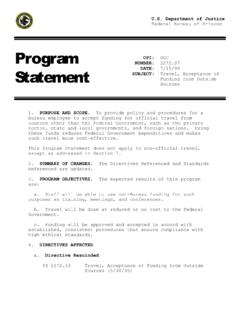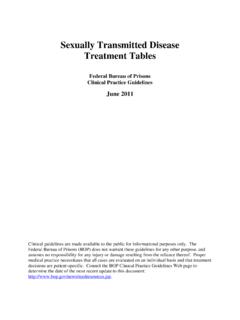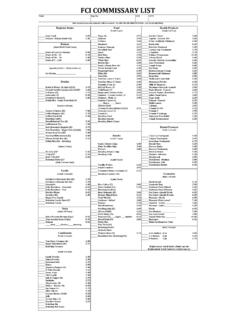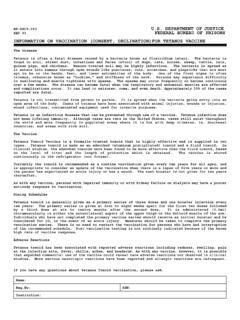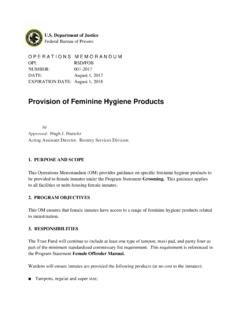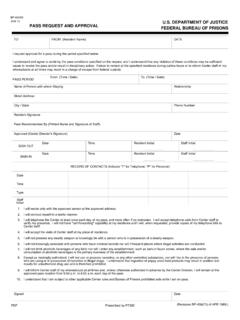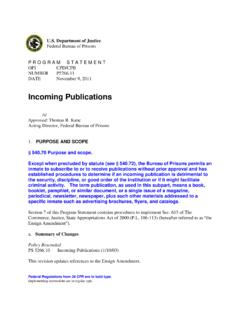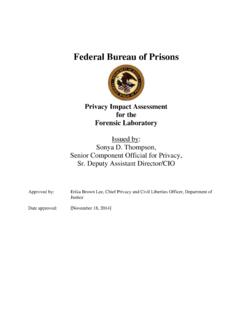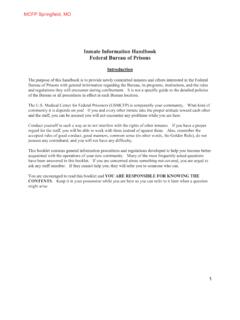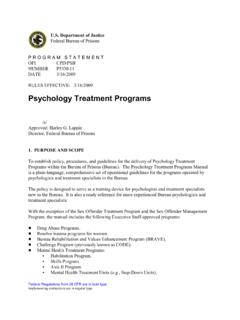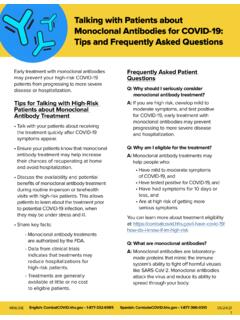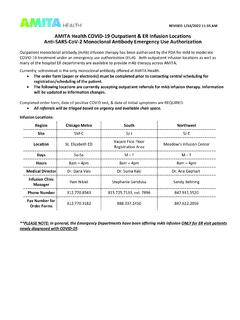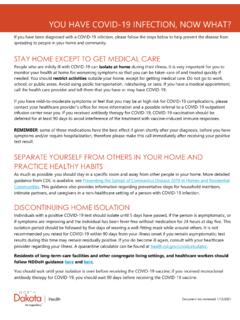Transcription of Monoclonal Antibody Therapy for COVID-19
1 Monoclonal Antibody Therapy for COVID-19 . federal bureau of Prisons Clinical Guidance December 19, 2020. federal bureau of Prisons (BOP) Clinical Guidance is made available to the public for informational purposes only. The BOP does not warrant this guidance for any other purpose, and assumes no responsibility for any injury or damage resulting from the reliance thereof. Clinical guidance may be adapted for the unique situations that present within BOP correctional facilities. Proper medical practice necessitates that all cases are evaluated on an individual basis and that treatment decisions are individual-specific. Referenced Program Statement versions within this guidance are for informational purposes only.
2 Please refer to the most current versions of any referenced Program Statement(s). Consult the BOP Health Management Resources Web page to determine the date of the most recent update to this document: federal bureau of Prisons Monoclonal Antibody Therapy for COVID-19 . Clinical Guidance December 2020. Table of Contents A. PURPOSE .. 2. B. 2. C. PATIENT SELECTION .. 2. Confirmed SARS-CoV-2 infection .. 2. Clinical Presentation .. 3. Risk Factors for Severe COVID-19 Illness .. 3. Exclusions to Treatment with Monoclonal Antibody for COVID-19 .. 3. Patient Priority Levels .. 4. D. MEDICATIONS .. 4. E. PATIENT 5. F. DOSING, ADMINISTRATION, AND STORAGE .. 5. Adult Dosing .. 5. Preparation .. 5.
3 Dilution .. 6. Administration .. 7. Adverse Events .. 8. Storage .. 8. Nursing Protocol for Administering Monoclonal Antibody Infusion .. 8. Appendix 1. Nursing Protocol for Administering Monoclonal Antibody Infusions .. 9. Appendix 2. Protocol for Allergic Reactions to Monoclonal Antibody Infusions .. 12. 1. federal bureau of Prisons Monoclonal Antibody Therapy for COVID-19 . Clinical Guidance December 2020. A. PURPOSE. The purpose of this document is to provide guidance on the use of Monoclonal Antibody (mAb) for the outpatient treatment of mild to moderate COVID-19 in patients with certain risk factors for severe COVID-19 . illness. B. INTRODUCTION. Infection with SARS-CoV-2, the virus that causes COVID-19 , can lead to severe symptoms, hospitalization, and death.
4 Two Monoclonal Antibody products have received FDA Emergency Use Authorization for treatment of COVID-19 patients with mild to moderate symptoms and risk factors for severe illness. Studies have shown a 10% or greater absolute risk reduction in the need for emergency department visits and hospitalization with mAb treatment. Treatment has the potential to prevent progression to severe disease and decrease the number of inmates who need hospitalization in the local community, thereby reducing the overall strain on the healthcare system during times of peak SARS-CoV-2 transmission. Treatment appears to work best when started early after the diagnosis is made in appropriately-selected patients.
5 For that reason, it is recommended that each newly diagnosed inmate with COVID-19 be assessed for possible treatment with this medication. To prepare for this as part of their COVID-19 pandemic response plan, each institution will need to assess their ability to administer an IV infusion in consultation with regional healthcare leadership. In order to use these medications, institutions must be prepared to manage severe allergic reactions including anaphylaxis. Patients meeting criteria for treatment with Monoclonal Antibody will also meet criteria for medical isolation. Staff who have direct or close contact with the patient will need to wear PPE and follow procedures as described in Modules 2 and 3 of the BOP COVID-19 Pandemic Plan, which may be found at #1_2.
6 C. PATIENT SELECTION. The following criteria must be met in order for a patient to be considered for treatment with COVID-19 . Monoclonal Antibody Therapy . See below for a more detailed description. Positive results of direct SARS-CoV-2 viral testing and A clinical presentation of mild to moderate COVID-19 symptoms and Symptom onset within the 10 days preceding mAb treatment and Risk factors for severe COVID-19 illness (see Risk Factors for Severe COVID-19 Illness below) and Age 12 years old; weight 40 kg (88 lb). CONFIRMED SARS-COV-2 INFECTION. Patients must have positive results of direct SARS-CoV-2 viral testing no more than 10 days prior to starting the mAb infusion. Commercial lab PCR test, rapid PCR test (Abbott ID Now) or Rapid Ag test (BinaxNOW) are all acceptable means of confirming infection.
7 2. federal bureau of Prisons Monoclonal Antibody Therapy for COVID-19 . Clinical Guidance December 2020. CLINICAL PRESENTATION. Patients with risk factors for severe COVID-19 illness and one or more of the following mild or moderate COVID- 19 symptoms may be considered for treatment with mAbs for COVID-19 : Fever Cough Sore throat Malaise Headache Muscle pain Gastrointestinal symptoms Shortness of breath with exertion. Symptom onset must be within the 10 days preceding mAb treatment. RISK FACTORS FOR SEVERE COVID-19 ILLNESS. Treatment is indicated for patients who are 18 year old with at least one of the following risk factors for progression to severe disease: Body mass index (BMI) 35. Chronic kidney disease (CKD).
8 Type 1 or type 2 diabetes Immunosuppressive disease 65 years of age Are currently receiving immunosuppressive treatment 55 years of age AND one of the following: cardiovascular disease (CVD). hypertension chronic obstructive pulmonary disease (COPD) or other chronic respiratory disease EXCLUSIONS TO TREATMENT WITH Monoclonal Antibody FOR COVID-19 . Treatment is not authorized by the FDA EUA for use in patients with any of the following conditions: Hospitalized due to COVID-19 . Require oxygen Therapy due to COVID-19 , OR. Require an increase in baseline oxygen flow rate due to COVID-19 in those on chronic oxygen Therapy due to underlying non- COVID-19 related comorbidity Patients with any of the following criteria should be excluded from further evaluation for treatment with mAbs for COVID-19 based on clinical indicators of severe infection: Oxygen saturation (SpO2) 93% on room air Respiratory rate 30 per minute Heart rate 125 per minute Inmates with clinical indicators of severe COVID-19 illness should be considered for transfer to an outside hospital, as clinically indicated.
9 3. federal bureau of Prisons Monoclonal Antibody Therapy for COVID-19 . Clinical Guidance December 2020. Other criteria which may exclude a patient from treatment include: Pregnancy and lactation: Safety and efficacy of COVID-19 mAbs are not known in these populations. Treatment may be considered on a case-by-case basis. COVID-19 Monoclonal antibodies should not be administered to anyone with known allergies to any of the components used in the formulation of the interventions PATIENT PRIORITY LEVELS. When quantities of bamlanivimab (BAM) or casirivimab and imdevimab (CAS/IMD) are limited, patients may need to be prioritized for treatment. The following are suggested priority criteria for use in these situations, which may be adapted as appropriate and as needed dependent upon circumstances at each institution.
10 PRIORITY 1 PATIENT CRITERIA: Three or more risk factors for progression to severe disease or 3 days of symptoms or Any one of the following risk factors: Body mass index (BMI) 35. Type 1 or type 2 diabetes 65 years of age PRIORITY 2 PATIENT CRITERIA: Two or more risk factors for progression to severe disease PRIORITY 3 PATIENT CRITERIA: One risk factor for progression to severe disease Contact the Regional Medical Director (RMD) to discuss any proposed deviation from the above criteria. Submission and approval of a non-formulary request is required prior to initiation of either medication. D. MEDICATIONS. At this time two Monoclonal Antibody therapies have received Emergency Use Authorization from the FDA for patients who are COVID-19 positive.
